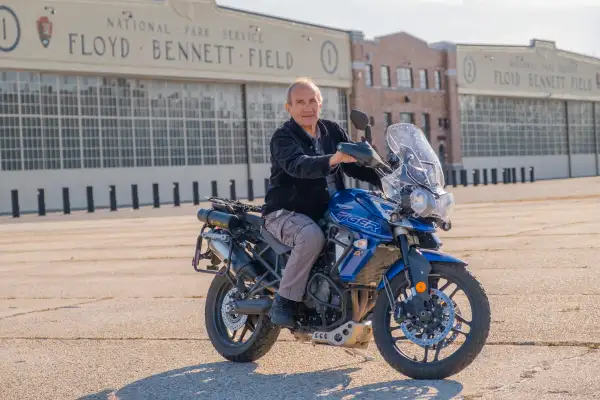Into the Wild: One Retiree's 9,500-Mile Motorcycle Journey from Brooklyn to Alaska (and Back!)

To passing motorists, George Perlstein’s license plate may look like a string of random letters. But LSKNBK honors a promise the Brooklyn retiree made to himself when he bought his Triumph Tiger 800 motorcycle in January.
It stands for “Alaska and back.” For years, Perlstein, 71, had wanted to travel to the Arctic Circle on his motorcycle. But when he bought his Triumph, he was so stiff he could barely swing his leg over it to sit down.
At the time, Perlstein was still recovering from a serious motorcycle accident he had in 2017, where he sustained a compound break in his right leg, a crushed right heel, a broken right forearm, and a torn ligament in his right hand. He spent a month in the hospital, then two months in a rehab facility. In the process, the former skilled electrician and heavy-equipment technician lost his strength and his can-do spirit.
“The self-doubt manifested in fear,” he says. “I had to get over that.”
He embarked on a painstaking recovery, starting with the simple practice of getting on and off the motorcycle and graduating to test runs on the quiet roadways of nearby Floyd Bennett Field. Perlstein’s efforts culminated this summer in a solo, 9,500-mile journey to Alaska and back. Perlstein wanted to take the trip for himself, of course, but he also wanted to send a message to his two children and two grandchildren. “I want to leave a certain legacy, that life goes on,” Perlstein says. “What is that expression in basketball? You miss every shot you don’t take.”
Here’s how he did it.
Buddy Up
Before he left, Perlstein asked around the local riding community to see if anyone wanted to join him for the trip, but he wasn’t troubled when he got no takers. “I was OK leaving on my own,” he says, “because I knew that I would be meeting other motorcyclists along the way, and whether we rode together for an hour, a day, or a week, I would never be alone.”
As he anticipated, he wound up with plenty of riding buddies. One got him over a particularly rough stretch in Alaska, after Perlstein traveled north from Fairbanks on the Dalton Highway. “It was the poorest excuse of a road,” he recalls. The “highway” was in fact gravel, and his bike skidded over the loose rocks and threatened to veer over a 500-foot cliff that loomed just to the side.
“It was so bad, so rough, and so out-and-out scary” that Perlstien decided he could go no further, figuring he’d turn around when he got to the Yukon River Camp about 50 to 60 miles from his final destination. “I done good,” he thought to himself. “I’m not here to get killed.”
At the camp, he met up with about 20 motorcyclists. One of them, a mellow guy from Oklahoma, offered to continue on with Perlstein. He warned the man that he was slow, but the man said he didn’t mind. So Perstein decided to give it one more shot. “I got geared up and we took off,” Perlstein says.
The terrain didn’t improve, and Perlstein decided to end his trip about five miles from his ultimate destination at the Arctic Circle. But he’d made it so far, from his hospital bed two years ago to the majestic pine forests of Alaska, that he didn't beat himself up about it. The scenery where he stopped was "stark, and beautiful," he says, a far cry from the crowded streets of Brooklyn.
Take Your Time
While Perlstein planned for a trip of between five and six weeks, he ended up being gone for almost eight. He didn’t rush, stopping along the way to meet up with his girlfriend, Kathy Burger, who'd flown in for a rendezvous in St. Paul, Minn., and then again for a “mental health day” in Minot, N.D., where he found a chiropractor who worked wonders on his long-standing sciatica pain.
While the relaxed pace was good for Perlstein’s body, it was a bit harder on his budget. Perlstein estimates that he spent a little over $8,000 on his journey, including the gear he bought in preparation. Still, that total wasn't bad for two months on the road, and Perlstein could comfortably fund it through his retirement income of Social Security, a pension from his former job as a New York City worker, and rental income from the apartment he rents out of the three-family brick building he owns in Flatbush, Brooklyn, where he also lives.
Perlstein dealt with some unanticipated logistics along the way, like having to buy a SIM card when he realized he had no cell phone reception in Canada, and calling his pharmacy to have his prescription refills sent to North Dakota “so I was able to get to Canada without croaking,” he laughs.
Luckily, there were no big surprises to contend with, just routine costs for food, lodging, and bike maintenance. The unexpected expenses he ran into were small, like the eye mask he realized he needed to sleep during the nearly 24 hours of Alaskan daylight.
He’d timed his trip to experience the summer solstice, and he made it to Alaska just a few days late. He returned to Brooklyn in late July, happy he’d written his own ending to what could have easily been the end of his riding career. “I decided the accident wouldn’t be my whole story,” he says. “I’m really glad I did it.”
